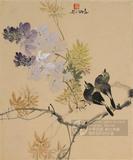明文徵明書蘭亭敘 卷
推薦分享
資源連結
連結到原始資料 (您即將開啟新視窗離開本站)後設資料
- 資料識別:
- 故書000101N000000000
- 資料類型:
- 類型:書法
- 型式:文字
- 著作者:
- 文徵明
- 出版者:
- 數位化執行單位:國立故宮博物院
- 日期:
- 明世宗嘉靖三十七年(1558)
- 格式:
- 本幅 29.2x120.4公分、隔水一 12公分、隔水二 12公分
- 語言:
- 漢文
- 關聯:
- 石渠寶笈初編(重華宮),下冊,頁769 &*故宮書畫錄(卷一),第一冊,頁106 &*文徵明(西元一四七○-一五五九年),江蘇長洲人。本名壁,字徵明,後以字行,別號停雲生、衡山居士。詩文書畫俱工,與沈周、唐寅、仇英共稱為明四大家。其書初學宋元,後法晉唐,各種書體無一不精。本幅結字縝密,筆法內斂含蓄,而精神外露,風彩煥發。據卷末自題,知此卷乃文氏八十九歲所作,而筆意蒼勁有力,無渙散之感,當為佳作。&*故宮歷代法書全集,第六冊,頁43-51、222-223&*Wen Cheng-ming (1470-1559) was a native of Ch’ang-chou, Kiangsu. His given name was Pi, his style name was Cheng-ming, and his sobriquets were T’ing-yün-sheng and Heng-shan chü-shih. He was known by his style name in later years. An accomplished poet, writer, painter, and calligrapher, he is known along with Shen Chou (1427-1509), T’ang Yin (1470-1523), and Ch’iu Ying (ca. 1494-1552) as one of the Four Masters of the Ming Dynasty. When Wen first started writing calligraphy, he studied the calligraphy of the Sung (960-1279) and Yüan (1279-1368) dynasties. His later calligraphy followed styles of the Chin (265-420) and T’ang (618-907) dynasties. Any script which Wen chose to write was exquisite. The brush method used in this work seems to hold an inner strength, and its spirit seems to exude from the characters, creating a radiant and luminous style. According to an inscription on the end of this scroll, this work was executed when Wen was eighty-nine. The brushstrokes of this fine work, however, are still vigorous, without any hint of hesitation or lack of concentration.&*1.江兆申,〈文徵明書蘭亭序 卷〉,收入國立故宮博物院編,《吳派畫九十年展》(臺北:國立故宮博物院,1975年初版,1976年再版,1981年三版),頁318。
- 管理權:
- 國立故宮博物院
授權聯絡窗口
- 國立故宮博物院圖像授權、出版授權、影音資料授權-申請流程說明
http://www.npm.gov.tw/zh-TW/Article.aspx?sNo=03003061






